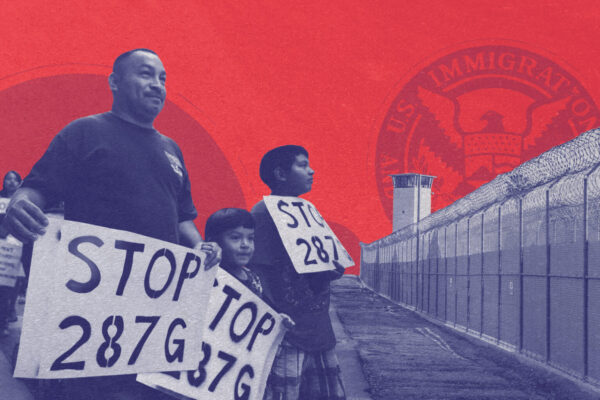President Trump is supremely committed to achieving his goal of carrying out the largest mass deportations in American history.
He’s tried to take away protections from hundreds of thousands of migrants and launched a full-scale assault on non-citizens who voice opinions he doesn’t like. And he’s illegally deported hundreds of people to a hellhole El Salvadorian prison – including at least one person who the administration deported by mistake but refuses to bring back.
This is just a small sampling of the administration’s anti-immigrant efforts, and Trump is just getting started. The president is happy to act on his own to sow terror in immigrant communities. But he’s equally eager to make state and local governments do his dirty work for him – including by expanding the notorious 287(g) program.
What is a 287(g) Agreement?
The Illegal Immigration Reform and Immigrant Responsibility Act of 1996 added Section 287(g) to the Immigration and Nationality Act. This section authorizes ICE to give state and local law enforcement officers the authority to carry out certain immigration enforcement duties. Essentially, 287(g) agreements turn state and local police into arms of ICE and divert the time and attention of local officers toward enforcing federal immigration law. Critically, law enforcement agencies can only participate in a 287(g) if the agreement doesn’t conflict with state or local laws.
A 287(g) agreement is entirely voluntary – local law enforcement have no obligation to participate in the program or enforce immigration law. By signing an agreement, a law enforcement agency is effectively declaring its support for a cruel federal immigration enforcement regime.
Which Counties in Wyoming Have 287(g) Agreements?
As of July 10, 2025, there are law enforcement agencies in five counties in Wyoming that have 287(g) agreements: the Campbell County Sheriff’s Office, the Carbon County Sheriff's Office, the Laramie County Sheriff’s Office, the Natrona County Sheriff’s Office, and the Sweetwater County Sheriff’s Office.
What Types of 287(g) Agreements Are There?
There are three types of 287(g) agreements: the Jail Enforcement Model, the Warrant Service Officer Model, and the Task Force Model. Given the rapid changes in immigration enforcement under the Trump administration, it’s possible the way these programs operate could change or that new models could emerge.
Jail Enforcement Model
Under this model, ICE delegates certain immigration authorities to state and local law enforcement agencies to identify immigrants in state and local custody and place them into immigration proceedings. Corrections officers in local jails, under the supervision of ICE, are deputized by the federal government to interrogate people in their custody about their immigration status and funnel people into the deportation pipeline. Laramie and Sweetwater Counties have this agreement with ICE.
Jail enforcement 287(g) agreements put immigration enforcement at the center of local jails, giving corrections officers duties they are ill-equipped to perform and raising the possibility of errors and abuse. These agreements are commonly accompanied by contracts to rent cell space to detain immigrants in removal proceedings or awaiting deportation, allowing counties to profit from the cruelty of immigration detention.
Warrant Service Officer
This type of agreement allows ICE to train, certify, and authorize state and local law enforcement officers to serve and execute administrative immigration warrants on people who are in custody in their agency’s jail. The federal government created this version of the program in 2019 and it’s sometimes referred to as “287(g)-lite,” because it has in the past required less training and delegated fewer responsibilities to local law enforcement. This is the type of 287(g) agreement that Campbell, Carbon, Laramie, and Sweetwater Counties have with ICE.
Task Force Model
ICE describes this type of agreement as “a force multiplier” that allows state and local law enforcement agencies to make immigration arrests during routine police enforcement. This model, the broadest and deepest form of collusion with ICE, essentially turns police officers into ICE agents. This is the type of 287(g) agreement that Laramie, Natrona, and Sweetwater Counties have with ICE.
The 287(g) task force model was discontinued under President Obama following a number of documented civil rights abuses associated with the program including racial profiling, most notoriously by Maricopa County, Ariz., Sheriff Joe Arpaio. This form of 287(g) agreement was not brought back even under the first Trump administration. ICE resurrected the model just this year.
Depending on how each specific agreement is crafted and enforced, all three 287(g) models may expose local law enforcement agencies to potential liability for constitutional and legal violations.
Why Are 287(g) Agreements Harmful?
While they are not the only form of collusion between ICE and local law enforcement, the existence of a 287(g) agreement in an area sends an unmistakable message to local communities that law enforcement is targeting them.
All Wyomingites, regardless of immigration status, want to live free lives, participate in their communities, and provide for their family. But for some Wyomingites, their immigration status means they live in fear that interacting with a government agency could have catastrophic consequences for themselves or their loved ones.
A 287(g) agreement magnifies this fear many times over because it turns local police into weapons of ICE. Particularly under a task force model, where officers are deputized to enforce immigration law in the field, it increases the likelihood that a minor law enforcement encounter could put someone on the path to deportation.
In the current climate of intense fear, families are scared to seek life-saving medical care and parents are keeping their children home from school. When local authorities are acting on behalf of ICE, these concerns only grow. This kind of environment, in which many Wyomingites are terrified to reach out for help, won’t make any of us safer.
In fact, the opposite is true. Data shows crime is lower in places where officials do not divert time and resources for a hostile immigration agenda.
How Can We End 287(g) Agreements and Prevent New Ones?
It's time to put an end to ICE’s 287(g) agreements and call the government to task on remedying the harm made from this program. Start by contacting your local officials: Reach out to your local sheriff, county commissioners, or other relevant officials to express your opposition to 287(g) agreements.



